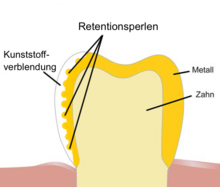Retention (dentistry)
The term retention (from Latin : retinere "to hold back") is used several times in dentistry :
Tooth retention
Tooth retention occurs when a tooth remains trapped in the jaw and does not break through, although it or its germ is almost in the right place. The causes for this can be varied:
- Teeth crowded or simply lack of space
- Tooth germ shift
- Tooth germ damage or adhesions
- Cysts
- (Past) jaw fractures
- Cleidocranial Dysostosis
- Dystrophia brevicollis congenita
- Klippel-Feil Syndrome
Due to a lack of space, wisdom teeth and upper canines in particular retain their hold (this is also referred to as impaction ) . In terms of frequency, the lower premolars follow (by a large margin) . Surplus teeth (see hyperdontia and mesiodens ), on the other hand, are very often retained. Retention of milk teeth, on the other hand, is rare.
If the retained tooth has a milk tooth predecessor , its root is often not resorbed (dissolved) and the milk tooth is therefore preserved.
The need for orthodontic treatment of retained or impacted teeth is recorded by the Index of Orthodontic Treatment Need (IOTN).
Anchoring a filling / restoration
In order to mechanically anchor plastic filling materials ( amalgam , composites, etc.) in the cavity, retentions (here in the sense of: undercuts or in the form of a "dovetail") are attached to prevent the filling from falling out. Retention is the property of a preparation to counteract the removal of a restoration against its insertion direction. Vertical pulling forces can occur in the mouth with very sticky foods or due to leverage in bridges.
Retention pins
Retention pins in the traditional sense belong to the retention elements of the filling gauge. They must not be confused with root canal pins that are fastened in the root canal and are used to anchor a build-up filling. There are different retention pins that differ in the form of anchoring in the tooth. Posts can be anchored in the tooth by cementation, friction or a thread. The material and the length of the pins vary. Pins with a length of approx. 4 to 6 mm made of gold, platinum or titanium alloys are common. In the case of cemented posts, the bore is larger than the post itself. The distance between the post and the bore is filled with cement. For pins that are anchored by friction, the diameter of the hole corresponds to that of the pin. In the case of threaded posts, the diameter of the pre-drilled hole in the dentine is smaller than the post to be anchored. The pin systems are mainly used for anchoring classic plastic filling materials such as. B. amalgam or dental cements used. These materials are increasingly being replaced by composite filling materials, so that the use of retention pins is also continuously decreasing.
Retention points
Retention points in the dentition are areas that are particularly difficult to access for teeth cleaning and therefore have an increased risk of caries . Such risk areas are: tooth fissure , inter- tooth surfaces ( approximal ), tooth neck , foramen caecum dentis (blind hole inside ( palatal ) on the upper incisors) and filling and crown margins .
See: predilection point
Retention phase in orthodontics
Towards the end of an orthodontic treatment, the reshaped jaw and the corrected tooth position are fixed using special devices ( retainers ) in the retention phase .
Retention prosthesis
A retention prosthesis is a partial prosthesis in which the retaining elements (brackets, also called gingival brackets here ) are made of colorless or tooth-colored base material for the prosthesis. Such prostheses are now uncommon and are by no means recommended because they inevitably involve extreme retention points (see above).
Retentions in dental technology
In order to achieve retention for veneering plastics or the connection between the model casting base and the denture resin, small, almost spherical elevations (approx. 0.5 mm), retention bars or loops are attached to the (precious) metal framework, which ensure that both materials are mechanically anchored .
Individual evidence
- ^ Joseph Maria Stowasser : Der Kleine Stowasser , Latin-German school dictionary , G. Freytag Verlag, Munich.
- ↑ Eberhard Krüger: Textbook of Surgical Dentistry, Oral and Maxillofacial Medicine, Volume 2 , book and magazine publisher “Die Quintessenz”, Berlin.
swell
- Walter Hoffmann-Axthelm : Lexicon of Dentistry , Quintessenz-Verlag, Berlin
- Joachim Gabka / Herbert Harnisch: Operation course for dentists , Georg Thieme Verlag, Stuttgart
- B. Willershausen-Zönnchen and O.Butenandt: Pediatric Dentistry - A Guide for Doctors and Dentists , Urban & Fischer, 1998. ISBN 3-541-15971-5
- Gottfried PF Schmuth: Orthodontics - Basics and Problems , Georg Thieme Verlag, Stuttgart
- Eberhard Krüger: Textbook of surgical dentistry, oral and maxillofacial medicine, Volume 2 , book and magazine publisher “Die Quintessenz”, Berlin



